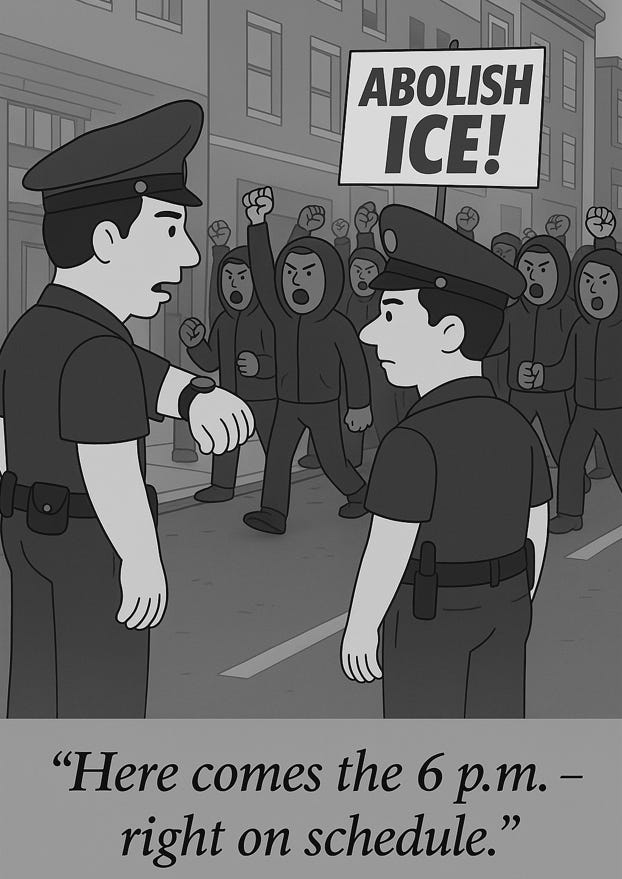Sunday Ops Report
L.A. in flames (again); That magic autopen; Is Comey in legal trouble?; And are we ready for the next war -- or fighting the last one?
As an English poet once wrote in far less turbulent times: “The world is too much with us.” Can you imagine what he’d say today?
We have a long Ops Desk Dispatch this week, gang. Just too much happening.
The Los Angeles ICE Riots: PROSECUTE!
As we’ve all seen by now, violence has once again erupted in Los Angeles — this time under the banner of protesting ICE enforcement actions. Protesters have taken to the streets not just with signs and chants, but with projectiles aimed at federal officers, destruction of public property, and physical obstruction of lawful operations. Let’s be clear: this is not protest — this is crime.
But it’s also an opportunity. Let me explain.
When individuals throw bottles, bricks, or fireworks at ICE agents, they are committing a felony under federal law (18 U.S.C. § 111). No cause, no slogan, no chant justifies assaulting law enforcement officers. These aren’t spontaneous bursts of anger — they are part of a pattern we’ve seen across major cities and campuses: coordinated attacks on authority, property, and public order under ever-shifting ideological pretenses.
Who is coordinating this? Funding it? Has that stuff been mapped? Under the Biden administration, we know that the answer was, of course, a resounding no.
But things are finally changing. Here’s a recent arrest that shows what can be done when DOJ actually wants to enforce:
And of course, there’s “Maryland Dad” Kilmar Abrego Garcia, brought back from El Salvador. Not for the “due process” Senator Chris “Margaritaville” Van Hollen insisted on — but to face human trafficking charges.
A recent video posted by Fox field reporter Bill Melugin (@BillMelugin_) shows the kind of individuals ICE is targeting: repeat criminal offenders, including those with multiple prior deportations and ties to organized crime.
The outrage directed at their arrests is not about civil liberties — it’s about indulging radicalized opposition to any form of immigration enforcement, no matter how justified.
In response to the violence, the Mayor, the LAPD Police Chief, the LA County Sheriff, and the L.A. District Attorney Noah Hochman all issued nearly identical, mealy-mouthed statements that “condemned” violence in theory, but did not commit to prosecuting those attacking officers or destroying property. This kind of equivocation emboldens violent actors, who have learned that in Los Angeles and other blue cities, they can break the law with impunity.
That is why the federal government, under new leadership, must seize this chance. DHS and the DOJ should:
Identify and arrest individuals who assaulted federal officers;
Seize and examine phones, laptops, and communications of arrestees to map organized cells;
Prosecute in federal court, bypassing local reluctance to enforce the law.
This is not about immigration policy. It’s about public safety and the rule of law. The individuals throwing projectiles and assaulting ICE aren’t advocating for reform — they are attacking duly appointed federal officers taking action under the law.
And which, by the way, this country voted for.
And as we’ve seen time and time again, many of these anarcho-marxist rioters are part of a broader, recurring network of agitators who surface every time there is an opportunity to provoke chaos — from ICE protests to campus occupations to anti-police riots. It’s the Hamas wing of the Democratic party, well-funded, organized, and somehow always free to drop everything and answer the call. Don’t any of these people work?
The truth is: these riots have been indulged, not just by soft-on-crime prosecutors, but by a political culture in California and other blue areas that treat lawbreakers as misguided children. But children don’t get to throw bricks at federal agents without consequences.
The time for indulgence is over. Time for federal enforcement and accountability.
Arrest; debrief; flip; get search warrants; map and penetrate the networks. Put a few hundred in federal prison on serious charges.
And suddenly, our streets and campuses will look a lot more like… streets and campuses.
Joe Biden’s Poison Autopen
A poison pen letter is usually sent anonymously. It appears Joe Biden’s signature may have been affixed anonymously in many or even most cases. Citizens should be outraged by this practice and demand answers. The individuals behind this apparent fraud remain unidentified.
The U.S. Constitution is clear. Article I, Section 7 states:
“Every Bill which shall have passed the House of Representatives and the Senate, shall, before it become a Law, be presented to the President of the United States; If he approves he shall sign it, but if not he shall return it with his Objections…”
“If he approves, he shall sign it.” No mention of assistants, proxies, or mechanical devices that mimic the signature. There’s no wiggle room.
Yet important laws and executive orders have been signed using an autopen—by unknown individuals.
This practice appears to stretch back decades. A 1995 Justice Department memo, written under President George H.W. Bush, and authored by Howard C. Nielson (later a Trump-appointed federal judge), wrote that the autopen use doesn’t violate the Constitution.
Whether this practice emerged from convenience, laziness, or something darker, it represents a serious breach. Nielson’s legal acrobatics might be comical if the stakes weren’t so high. The executive branch wanted the autopen, and Nielson provided the rationale.
Nielson’s rationale begins by asking what the “legal understanding” of the word “sign” was when the Constitution was drafted. It’s a move that recalls Bill Clinton’s infamous deflection of asking what the “meaning of the word is, is.” Nielson even cites an 1892 Massachusetts contract case about liquor sales as justification. Newsflash: federal law isn’t the same as a 19th-century booze deal.
He goes on to cite English legal precedent from the 1600s. But his argument boils down to: intent over action. That might seem plausible—except the Constitution doesn’t say “cause to be signed.” It says, “sign.”
Now, 235 years later, we see why. We have a mentally compromised president installed by opaque processes and unknown powerbrokers. Biden likely didn’t know about many of the bills he “signed,” nor understand those he did.
So who actually signed them? We don’t know. Were they acting in America’s interest? Who can say. And who is accountable for mistakes or criminal conduct stemming from those documents?
President Trump has ordered an investigation. Is it politically motivated? To a degree, of course. Trump is no constitutional purist.
But nonetheless, this investigation is critical. The practice of anonymous designees signing on behalf of the president must end. Arguments that the president might be unavailable for time-sensitive documents don’t hold water in the digital age.
Only a duly elected president can be held responsible for the laws signed into existence. We cannot outsource that authority to a nameless inner circle. The Founders understood that—and they were right.
Either way, we hope Trump’s investigation identifies those responsible and ends this disgraceful autopen practice once and for all. Our presidents should be able to sign their own names a few hundred times over the course of four years. It’s little enough to ask.
Will James Comey Be Prosecuted? (and no, we don’t mean for the seashells…)
The Hillary Clinton computer server case — not prosecuted…. A bogus FISA warrant issued to investigate Donald Trump, resulting in the Crossfire Hurricane investigation that ate up Trump’s first term…. Secret files kept away from the FBI’s normal reporting stream, and away from Congress….
All roads lead to James Comey. And now the FBI is investigating.
We don’t have to speculate. FBI Director Patel and Assistant Director Bongino told us so. They haven’t been saying much — but they’re saying that. We take them at their word.
What are they finding? Will it lead to an indictment?
So join Paul, Chris, and Eric this week on to pull it all apart, operationally and prosecutorially. Will we really see a former FBI Director indicted?
Either way — something’s coming. You will have heard of it here first.
Click below for a preview… or HERE for the full podcast.
Are We Fighting “The Last War”?
Throughout history, innovations have transformed warfare—the Greek phalanx, Roman siege weapons, and the introduction of gunpowder all revolutionized the battlefield. In more modern times, the machine gun rendered massed formations and cavalry obsolete, turning World War I into the most devastating conflict of its era.
Later, air power and carriers turned battleships from fearsome weapons into liabilities. In December 1941, the British battleship HMS Prince of Wales was sunk by Japanese aircraft. The Japanese lost only three planes while destroying what was then the most advanced battleship in the world. And we all know what occurred at Pearl Harbor.
This week, in Siberia, we witnessed another shift. Ukrainian forces launched Operation Spider’s Web, deploying drones from trucks outside a strategic Russian airbase thousands of miles from the front lines. The operation likely cost Ukraine just over $100,000 but destroyed an estimated $7 billion in Russian aircraft, severely degrading their strategic bombing capabilities.
Drone warfare isn’t new, but this attack was a wake-up call. As drone capabilities advance, autonomous controls and Frequency-Hopping Spread Spectrum (FHSS) communications are overcoming jamming systems. Modern drones are hard to shoot down. It seems drone attack technology is outpacing drone defense.
The United States has been developing drone defenses for years. But are we ready for a Spider’s Web-style attack on a large scale? Could a surprise drone strike cripple our navy at the dock, much like Pearl Harbor? Could inexpensive, remote-controlled aircraft neutralize the strategic air superiority the U.S. has maintained since World War II? Is tank warfare obsolete on drone-dominated battlefields?
These are troubling questions for the world’s preeminent military power. Drone warfare levels the playing field for nations with far less military and economic strength. The implications for potential terror attacks within the U.S. are even more disturbing.
We don’t expect public disclosures of classified military strategy. As much as we value transparency, this is rightly top-secret stuff. But it is essential that military planning faces proper government oversight. History has shown that even elite militaries often prepare to fight the last war — not future ones. Calls for smart changes in resource-allocation are too often ignored, with disastrous consequences.
Drone warfare may be the most significant development since the atomic bomb. The Trump Administration must ensure that our defense spending matches today’s threats. And drones appear to be the new frontier of combat.
Our military is certainly capable of learning from past mistakes. But is it doing so? See below — maybe even the conflict with the Houthis will tell us.
From Barbary Pirates to Houthi Militants
In our Inbox right now: a piece from The Wall Street Journal titled, “How the Houthis Rattled the U.S. Navy—and Transformed Maritime War.” And as luck would have it, Paul is currently reading Brian Kilmeade’s book, Thomas Jefferson and the Tripoli Pirates: The Forgotten War That Changed American History (a terrific read, by the way — Kilmeade’s books are great reading).
The lesson I come away with from assessing the two sources? If you want to protect American shipping in that part of the world, you will unfortunately have to kill some people that want to kill us.
It goes thusly. In the early 1800s, America’s third president, Thomas Jefferson, faced a dilemma. American merchant ships were under attack in the Mediterranean by Barbary pirates—state-sponsored Islamic raiders from North African territories like Tripoli, Algiers, and Tunis. These pirates demanded tribute in exchange for safe passage, and had no compunction about killing or brutally interning American seamen (who they viewed as apostates and so, not worthy of regard). It was a system Jefferson had no intention of perpetuating, despite America’s lack of funds or a real navy.
After various failed attempts at diplomacy, Jefferson resorted to force. He deployed the fledgling U.S. Navy to the region, launching the First Barbary War (1801–1805) and ultimately breaking the pirates’ grip on American shipping.

More than two centuries later, the United States finds itself in a similar situation—only now it’s the Houthis of Yemen disrupting maritime traffic in the Red Sea.
Since late 2023, the Houthis—armed by Iran—have launched dozens of drone and missile attacks on commercial vessels and U.S. warships in the Red Sea and Gulf of Aden. Despite initial attempts at deterrence and negotiations, these attacks have persisted.
The U.S. Navy has responded with the most sustained maritime combat operations since World War II. Yet even after expending over $1.5 billion in munitions and losing aircraft and personnel, the threat continues.
The lesson? In that region, only overwhelming force has ever secured American maritime interests.
Jefferson’s war against the Barbary pirates set a precedent. Jefferson believed that rewarding extortion only encouraged more piracy. When the Pasha of Tripoli declared war by cutting down the flag at the U.S. consulate, Jefferson sent in the warships. The U.S. blockade and military pressure eventually led to a peace treaty favorable to the United States—no tribute, the release of American prisoners, and a halt to attacks.
The parallels to today’s Red Sea crisis are striking. Like the Barbary states, the Houthis see shipping lanes not as neutral commerce zones but as leverage in a broader conflict. Promises and truces—such as the recent “pause” negotiated in 2025—are almost certainly tactical moves, not signs of good faith. As with Jefferson’s era, any perceived weakness invites further aggression.
Force, not treaties, ended the Barbary threat. Force, not diplomacy, has been the only tool to blunt the Houthi campaign. The takeaway is not that diplomacy is useless, but that in this region, peace is the product of strength.
The U.S. Navy was created to fight pirates—and in 2025, it remains essential for that very same reason.
The Israelis will be a help here. Israel has been targeted by drones launched from Yemen (the Houthis home base), and the Israelis undoubtedly have some good targeting intel in the area.
Get other stakeholders involved here as well. The Saudis don’t want Iranian proxies like the Houthis right off their shores. European, Indian, maybe even the Turks would assist — their shipping goes through there as well.
We don’t advocate more foreign adventurism, or a drawn-out, treasury-draining war. We don’t assess one with the Houthis as likely. But if Iran, the Houthis’ sponsor, is to be shown that this will not be allowed, the Houthis must be brought to heel. Just as the Pasha of Tripoli was.
Enough. Any more interference from them: take the Houthis out. For good.
And finally…
Los Angeles, New York, Chicago, San Francisco, Oakland….
And coming to a city near you!


















It is telling that the cities in flames and experiencing high vicious crime rates are run by Democrat Mayors and DA's. There is a clue there if only the boneheaded voters would see it. Of course, when the Democrats stopped the federal requirement for Voter ID's in elections, shenanigans with the ballot boxes may/will continue to occur in those cities.
This entire piece is absolutely excellent. Marxists claiming to be patriots pitiful. They all need to be unmasked and prosecuted. The autopen is no surprise-remember Obama said he could run his 3rd term with his phone and the right person as a front man. Well guess what that's just what we have here treason and sedition.